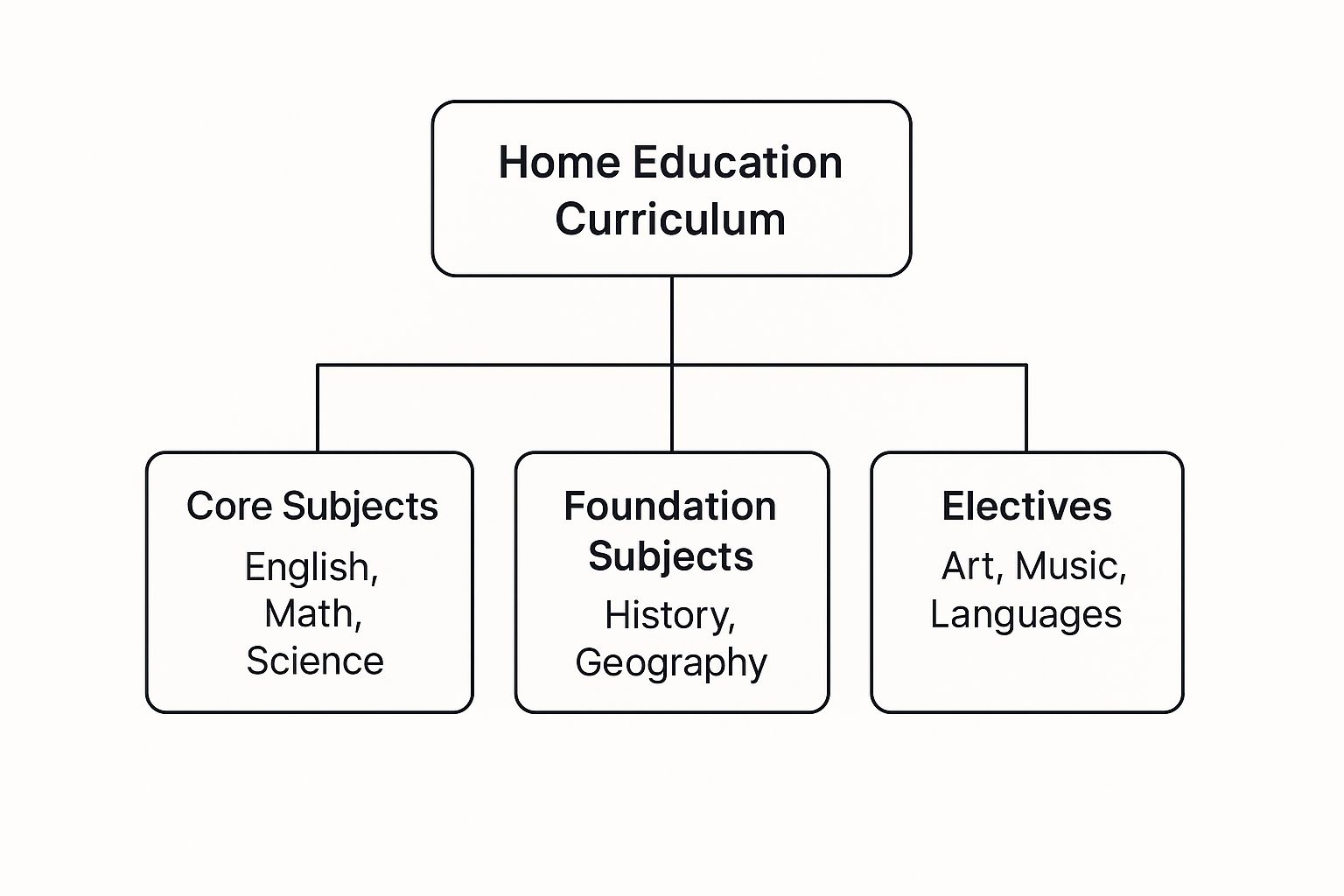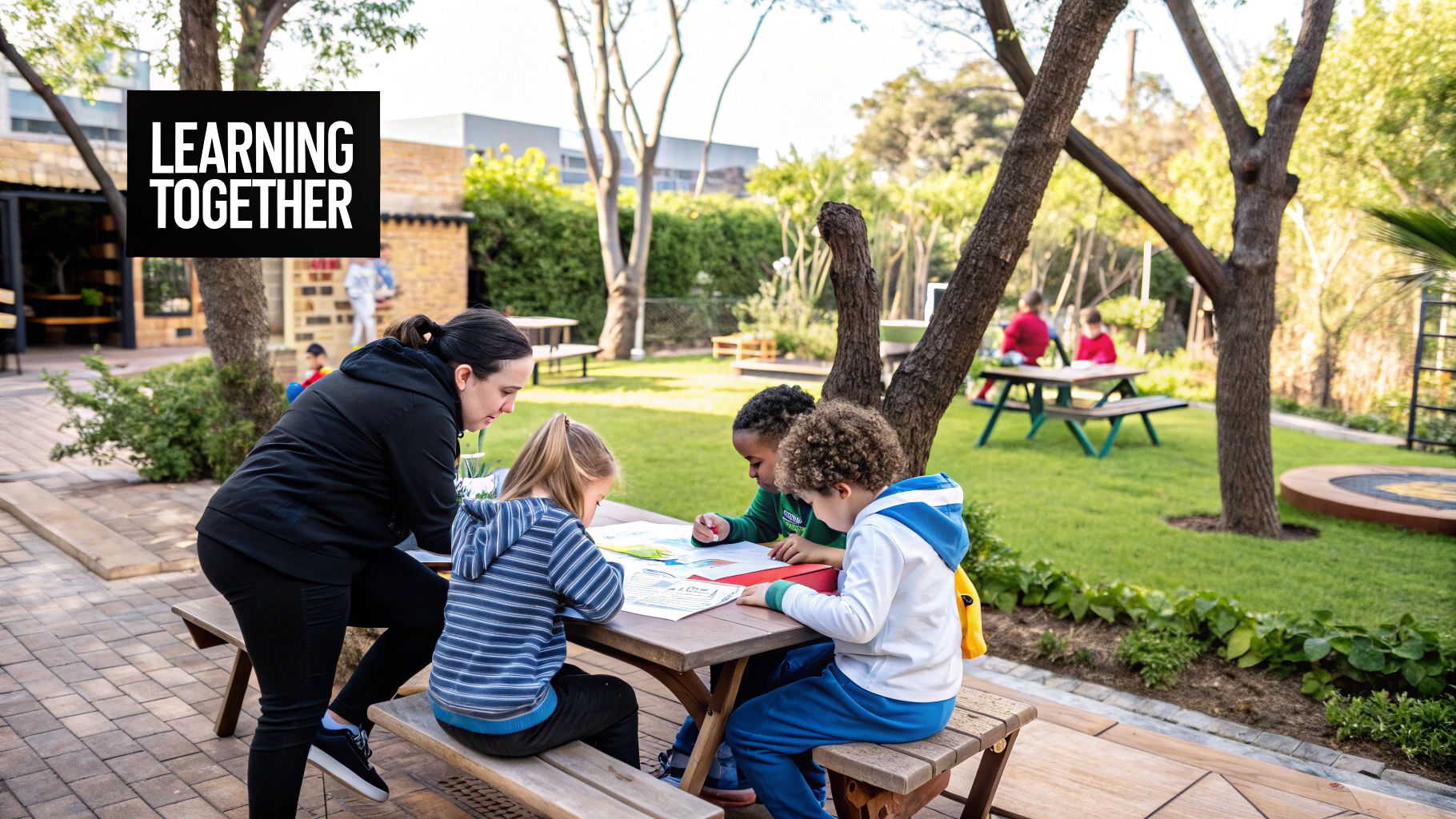Deciding on a UK home education curriculum can feel a bit like standing at the base of an unexplored mountain trail. You’re excited by the view, yet a little unsure which path to take. The key thing to remember is you don’t have to follow the National Curriculum to the letter. Your task is to offer an education that feels right for your child—one that suits their age, ability, and unique personality. That freedom, that ability to put your child first, lies at the very heart of home education.
Starting Your Home Education Journey
Choosing to teach your child at home usually comes from a place of deep care. You want to move away from a one-size-fits-all classroom and build something that resonates with who they are. This isn’t simply about transferring school lessons to your living room; it’s about watching their eyes light up with curiosity, nurturing their passions, and designing a learning experience that celebrates their natural strengths.
Often, families begin this journey with a single, compelling reason. Maybe your child blossoms in quieter surroundings, away from the hustle and bustle of a busy classroom that leaves them feeling overwhelmed. Or perhaps they’re bursting with creative ideas that never quite fit into a rigid timetable. Whatever the trigger, home education reframes learning as a living, breathing adventure rather than a checklist of subjects to be ticked off.
Why More Families Are Choosing This Path
Over the past decade, elective home education numbers have leapt from around 27,000 in 2010 to more than 153,300 in the 2023/24 academic year. Parents point to a range of reasons:
- 23% cite lifestyle or philosophical beliefs
- 14% highlight their child’s mental health as the driving force
This surge speaks to a growing desire for a more responsive, child-centred approach—one that places wellbeing and genuine enthusiasm at the forefront of learning.
The core idea is simple but powerful: instead of squeezing your child into a pre-existing system, you build a system around them. Their curiosity becomes the compass, and everyday moments turn into opportunities for discovery.
That flexibility means you set the pace. Imagine a young historian, completely captivated by ancient Rome, spending weeks crafting miniature catapults and exploring local ruins instead of racing through a textbook chapter. Or picture an aspiring painter, finally given the space to dedicate days to perfecting perspective, weaving maths into every brushstroke and crafting heartfelt stories about their favourite artists.
If you’re ready to explore practical steps and get started confidently, our guide on How to Homeschool in the UK offers straightforward advice. It’s all about creating a safe, encouraging environment where your child can thrive—both emotionally and academically.
Navigating the Legal Side of Home Education

Let's be honest, the legal side of home education can sound daunting. But the reality is far simpler and more freeing than most parents imagine. The law in the UK is built on a foundation of trust, giving you the freedom to craft an education that genuinely fits your child's heart and mind.
Your main legal duty is to provide a 'suitable' education. That word—'suitable'—is deliberately flexible. It doesn't mean you have to recreate school at home. Far from it. There’s no legal requirement to follow the National Curriculum, stick to school hours, or even have formal lessons every day. The law puts your child, not a rigid system, at the centre of their learning.
Understanding Your Rights and Responsibilities
So, what does 'suitable' actually mean in practice? It simply means an education that prepares your child for life in modern society. It needs to be right for their age, ability, and aptitude, and take into account any special educational needs they might have.
For a child obsessed with engineering, a 'suitable' education might be a mix of hands-on building projects, trips to science museums, and online coding clubs—fuelling their passion rather than forcing them to stare at a textbook. For a child struggling with anxiety, it means creating a calm, supportive space where they can learn without pressure, feeling safe enough to ask questions and make mistakes. This freedom is the cornerstone of a successful UK home education curriculum.
"The essence of home education law is not about imposing a rigid structure, but about ensuring every child receives an education that nurtures their potential and prepares them for the future, whatever that may look like."
How to De-register from School
If your child is currently at a mainstream school in England and Wales, taking them out is surprisingly straightforward. All you need to do is write a letter to the headteacher clearly stating your intention to home educate. Once they have your letter, the school is legally required to remove your child's name from their roll.
You are not asking for permission. It’s a notification. That moment can feel both liberating and a little nerve-wracking, but it's the first step towards reclaiming your child's education. You don’t need to submit a detailed plan or justify your decision. The only exception is for children attending a special school, where you will need to get the local authority’s consent first.
Working with Your Local Authority
Once you've de-registered, the school will let the Local Authority (LA) know. The LA has a responsibility to make sure all children are receiving a suitable education, so they will probably get in touch for an informal chat.
It's crucial to remember that you are in the driver's seat. You get to decide how to show them what you’re doing. This could be a friendly chat, a short written summary, or some examples of your child’s work. There is no one-size-fits-all approach, because every child is different.
- Practical Example 1: The Visual Learner – For a child who loves art, you could share photos of their detailed drawings of historical costumes, their handmade model of the solar system, and a short video of them explaining their latest creative writing project. This shows a rich, cross-curricular education in action.
- Practical Example 2: The Hands-On Explorer – You could share a journal that captures your child’s deep-dive into marine biology after a trip to the coast. This could include their pressed seaweed collection, research notes from documentaries, and a list of questions they're still exploring. It’s a beautiful snapshot of curiosity-led learning.
Both are perfectly valid ways to show a 'suitable' education is happening. The structure and content of the UK home education curriculum are entirely up to you. This flexibility has created a wonderfully diverse landscape of learning where families build their own unique educational paths.
If you’re looking for ideas on structuring your approach, our guide on online home education in the UK is packed with useful insights. Ultimately, your relationship with the LA should feel like a partnership, not an inspection. You know your child best, and your goal is simply to show how you are meeting their needs, one joyful discovery at a time.
Designing a Curriculum for Your Child
The thought of creating a curriculum from scratch can feel pretty daunting. But here's a secret: it's far simpler and more rewarding than you might imagine. Forget about trying to replicate a school timetable on your kitchen wall. Instead, think of it as a beautiful, ongoing conversation with your child about what fascinates them, what challenges them, and how they see the world.
Your first step is to let go of the idea that you need a rigid, pre-packaged plan. Your role isn't to be a strict instructor, but a guide, a facilitator, and a co-explorer. The whole point is to craft a learning experience that’s as unique as your child, one that feeds their natural curiosity and grows right alongside them.
Using the Key Stages as a Guidepost
While you’re not legally bound to follow the National Curriculum, its structure can be an incredibly useful map. Don't think of the Key Stages as a strict rulebook. See them as gentle guideposts, suggesting what children are typically exploring at different ages. This framework can bring a sense of order to your planning without stripping away the freedom and joy that makes home education so powerful.
Let’s break down what this can look like in practice, keeping your child’s needs and passions at the very centre of every stage.
Early Years Foundation Stage (EYFS) Ages 3-5
This stage is all about one thing: play. A child’s work at this age is to explore, experiment, and make sense of their world through their senses. A formal UK home education curriculum at this point would likely feel overwhelming and even counterproductive.
Instead, learning should be woven into the fabric of daily life, filled with connection and wonder.
- Kitchen Science: Baking a cake becomes a lesson in maths (measuring ingredients), science (watching ingredients transform), and following instructions. The joy isn't in getting the 'right' answer, but in the sticky, delicious process of discovering together.
- Nature Walks: A walk in the local park is a biology lesson in disguise. You can collect different leaves to study their shapes and colours, listen for bird calls, and talk about the changing seasons. It’s all about fostering a sense of wonder and connection to the world around them.
The infographic below gives a great visual of how you can structure a curriculum that balances core subjects with foundational skills and creative pursuits.

As you can see, a balanced approach doesn't require rigid separation. Subjects can be blended creatively to follow your child's lead.
Key Stage 1 and 2 (Ages 5-11)
As children get older, their capacity for more structured learning grows, but that powerful curiosity should still be the engine driving everything. This is the perfect time to introduce core subjects in a way that feels relevant and genuinely exciting to them.
Let's imagine your child is fascinated by space. This single interest can become the anchor for a whole term's worth of learning, tailored completely to them.
- English: They could write thrilling stories about alien adventures or create a "space explorer's log" detailing their factual discoveries about the planets.
- Maths: You could calculate the distance between planets, explore the geometry of constellations, or even design and build a model rocket to scale, feeling the pride of seeing their creation take shape.
- Science: This one’s a no-brainer! You can dive into gravity, planetary orbits, and the life cycle of a star, watching documentaries and visiting a planetarium to see it all come to life.
This project-based approach keeps learning meaningful. It answers that age-old question, "Why do I need to learn this?" because the knowledge is immediately applied to something they actually care about.
Key Stage 3 (Ages 11-14)
During these formative years, children start developing more abstract thinking and a deeper understanding of the world. Your curriculum can evolve to reflect this, encouraging critical thought and independent research into topics that ignite their personal interest.
What if your child develops a passion for social justice? This is a fantastic way to bring subjects like history, citizenship and English to life.
A curriculum built on curiosity doesn't just teach facts; it teaches a child how to learn. It fosters resilience, problem-solving, and a genuine love for knowledge that will serve them for a lifetime.
A documentary about the suffragettes could spark a project on women's rights. This might lead to reading biographies (English), researching key dates and laws (History), and even writing a letter to their local MP about a current issue they feel passionate about (Citizenship). The learning is deep, memorable, and driven entirely by their own sense of engagement. This approach is a core part of differentiated learning, where education is shaped to fit the individual. You can learn more about how to apply the principles of differentiated learning to your home education style.
To illustrate how this child-led approach can work across the stages, here’s a quick look at some practical ideas.
Home Education Approaches by Key Stage
| Key Stage | Focus | Maths Example | English Example | Science Example |
|---|---|---|---|---|
| EYFS (3-5) | Play & Discovery | Counting snacks, sorting toys by colour/size. | Storytelling with puppets, rhyming games. | Planting seeds, observing weather. |
| KS1 & KS2 (5-11) | Interest-Led Projects | Calculating project budgets, measuring for a build. | Writing a blog, creating a comic book. | Building a simple circuit, researching a habitat. |
| KS3 (11-14) | Independent Research | Using spreadsheets for data, learning about financial literacy. | Debating a topic, analysing historical documents. | Conducting an experiment, investigating a local environmental issue. |
| KS4 (14-16) | Formal Study & Application | Revising GCSE syllabus topics through real-world problems. | Analysing set texts, writing critical essays. | Following GCSE practical requirements, visiting science museums. |
This table shows how the focus naturally shifts from hands-on exploration to more formal study, all while keeping the child's interests and emotional needs at the heart of the learning.
Key Stage 4 (Ages 14-16) Preparing for GCSEs
If your child decides to pursue formal qualifications like GCSEs, this is when your curriculum will naturally become more structured. You’ll likely be working towards a specific syllabus for each chosen subject.
But even then, the spirit of child-centred learning doesn't have to vanish. The key is balance. You can supplement the required syllabus with activities that connect to their passions. For an English Literature student feeling bogged down by analysis, this could mean joining a local theatre group to see their set texts performed live, reigniting their love for the story. For a science student, it might involve volunteering at a local nature reserve, reminding them of the real-world wonder behind the theory.
Ultimately, designing a UK home education curriculum is a creative, heartfelt process. It’s about observing your child, listening to their ideas, and providing the resources and encouragement they need to chase them. It’s an education built on connection, trust, and the joyful pursuit of knowledge.
Finding Your Educational Philosophy and Resources

Here’s the thing about home education: there is no single ‘right’ way to do it. And honestly? That’s its greatest strength. Finding the approach that clicks with your family's values and your child’s personality is one of the most exciting parts of the whole journey. It’s about so much more than just picking a UK home education curriculum; it's about discovering a philosophy that makes learning feel natural, joyful, and deeply personal.
This is your chance to ask those big, important questions. Do you believe learning thrives with a predictable structure, or does it blossom with freedom and spontaneity? Does your child light up when they can chase their own curiosity down a rabbit hole, or do they feel safer and more confident with a clear path laid out for them? Getting real about the answers is the first step toward building an education that truly fits.
Exploring Different Educational Philosophies
The world of home education is brimming with different approaches, each with its own rhythm and focus. You don’t have to pick one and stick to it forever, either. Plenty of families mix and match, borrowing elements from several philosophies to create a unique hybrid that works perfectly for them.
Let’s explore a few of the most popular styles to see what might feel right for your child.
- Structured/School-at-Home: This approach mirrors a traditional school day, often using a pre-packaged curriculum with set timetables. For a child who feels anxious with uncertainty, this predictability can be incredibly calming and provide a secure foundation for learning.
- Classical Education: Rooted in ancient traditions, this method unfolds in three stages (the Trivium) that align with a child’s natural cognitive development. It puts a big emphasis on logic, debate, and diving deep into great books and historical texts.
- Charlotte Mason: This gentle philosophy is built on the idea that children are whole people who learn best from "living books" (rich, story-driven texts), spending time in nature, and being exposed to art and music. Lessons are kept short, honouring a child’s natural attention span and leaving plenty of time for exploration.
- Unschooling/Child-Led Learning: This is the most flexible approach by far. It operates on the principle that children are natural learners who will seek out knowledge when given the freedom and resources to follow their interests. For a child whose curiosity was stifled in school, this approach can be deeply healing, allowing them to rediscover their love for learning on their own terms.
The best philosophy is the one that brings peace to your home and a spark to your child's eyes. It's not about achieving perfection, but about fostering connection and a genuine love for learning.
To help you picture how these ideas play out day-to-day, the table below gives a snapshot of what each approach might look and feel like for different children.
Comparing Home Education Philosophies
This table compares some of the most common educational approaches, helping you find the best fit for your family's values and your child's learning style.
| Philosophy | Core Principle | Best For a Child Who… | Typical Daily Structure |
|---|---|---|---|
| Structured | Consistency and clear expectations. | Thrives on routine and measurable progress. | Set start/end times, distinct subject blocks. |
| Classical | Rigorous intellectual development. | Enjoys logic, history, and deep thinking. | Sequential learning, focusing on grammar, logic, rhetoric. |
| Charlotte Mason | Education is an atmosphere, a discipline, a life. | Is creative, loves stories, and connects with nature. | Short lessons, nature walks, art study, reading living books. |
| Unschooling | Learning is a natural byproduct of living. | Is highly curious and self-motivated. | No set structure; learning follows the child’s interests. |
Think of these as starting points, not rigid boxes. Most home educators find themselves somewhere in between, creating a custom blend that evolves as their children grow.
Building Your Toolkit of Resources
Once you have a better sense of your educational philosophy, you can start gathering the tools to bring it to life. The good news is you don’t have to create everything from scratch. There is a staggering amount of fantastic resources out there—many of them completely free—that can support your chosen approach and make learning richer.
Think of yourself as a curator, not a creator. Your job is simply to find and provide the materials that will light a fire in your child.
Online Curriculum Providers and Platforms
- Twinkl: An incredibly popular resource with a massive library of printable worksheets, lesson plans, and activities that align with the UK curriculum. It’s a lifesaver for structured and eclectic home educators alike.
- Oak National Academy: A government-backed platform offering free, high-quality video lessons and resources across all key stages. A brilliant supplement for any topic.
- IXL: This is fantastic for maths and English practice. It uses adaptive learning, meaning the questions get easier or harder based on your child’s answers, keeping them in that perfect sweet spot of being challenged but not overwhelmed.
Physical and Community Resources
Don't forget that your local community is one of your greatest educational assets. Museums, art galleries, and historical sites offer the kind of immersive learning that no textbook can ever replicate. These places bring history, science, and art to life, sparking conversations and new interests you never saw coming.
And perhaps most importantly, your local library. It's an absolute treasure trove of books, and often provides access to computers, workshops, and learning events. To really broaden your horizons, consider accessing a wide range of digital libraries and resources as well. This can open up a world of knowledge right at your fingertips.
Ultimately, finding your philosophy and the right resources is an ongoing process. It’s all about staying tuned in to your child’s needs, trusting your instincts, and building a supportive educational environment that truly feels like home.
Supporting Social Skills and Emotional Wellbeing

Let’s be honest and tackle the biggest myth about home education right from the start: socialisation. The question usually comes up with a hint of concern, as if children can only learn to get along with others inside a classroom.
But what if we reframe that? Real social development isn’t about being surrounded by thirty other kids of the exact same age. It’s about learning to interact meaningfully and respectfully with people from all walks of life—young and old, from different backgrounds and with different interests.
When you choose a UK home education curriculum, you're not closing social doors; you're opening up a world of richer, more varied social opportunities. Far from being isolated, research shows that home-educated children often participate in an average of 5.2 activities outside the home each week. It’s a statistic that completely dispels the myth of the lonely homeschooler.
Building Genuine Connections in the Real World
Real-world socialisation happens naturally when children are part of their communities. Instead of the often-artificial environment of a school playground, they learn communication, teamwork, and empathy in authentic, everyday settings. The possibilities are endless and can be beautifully woven into your child's learning journey.
Just think about the confidence a child builds chatting to the local baker about their passion for sourdough, or the sense of purpose they feel helping out at an animal shelter. These are the moments where social skills truly come alive.
Here are a few practical ideas to get you started:
- Join local home education groups: These are brilliant hubs for meeting like-minded families. You can organise group trips to museums, set up collaborative science projects, or simply meet at the park for a relaxed afternoon where the kids can play freely.
- Enrol in sports clubs or classes: Whether it’s football, gymnastics, or a martial arts dojo, these activities are fantastic for teaching teamwork, discipline, and how to handle both winning and losing with grace.
- Encourage community projects: Volunteering for a local park clean-up or helping an elderly neighbour with their shopping teaches compassion and civic responsibility in a way no textbook ever could. Imagine the pride your child feels seeing the tangible difference they've made.
A Safe Haven for Emotional Growth
Beyond social skills, home education can be profoundly good for a child’s emotional wellbeing. For many children who find the school environment overwhelming—whether due to anxiety, bullying, or simply feeling lost in the crowd—home can be a sanctuary. It’s a safe space where they can finally breathe, heal, and rediscover who they are without judgement.
When the constant pressure to fit in is removed, a child’s true personality has the room it needs to shine. They learn to trust their own instincts and build a strong sense of self-worth based on who they are, not how they measure up against their peers. This emotional security is the foundation for creating resilient, happy, and self-assured individuals.
Creating a nurturing environment isn’t about shielding your child from the world. It’s about equipping them with the inner strength and self-awareness to engage with it confidently and on their own terms.
Providing comprehensive anxiety help for teens is a vital part of supporting their emotional health, fostering a stable environment where they feel secure enough to learn and grow. In a home setting, you have the flexibility to address these needs with patience and understanding.
This might mean starting the morning with a calm mindfulness exercise instead of a frantic school run, or taking a break for a long walk when emotions are running high. By putting your child’s wellbeing at the centre of their education, you’re not just teaching them subjects; you’re teaching them that they matter. You're showing them, through your actions, that they are seen, heard, and valued for exactly who they are.
What About Exams and the Future?
It’s one of the biggest questions I hear from families weighing up a long-term UK home education curriculum: "What happens next?" The idea of navigating exams and university applications on your own can feel like a huge mountain to climb, but trust me, it’s a well-trodden path full of incredible opportunities. Home education doesn't close doors; it opens them in ways you might not expect.
The truth is, home-educated children are not at a disadvantage when it comes to getting qualifications. In fact, the very skills they nurture every day—independence, self-motivation, and a deep-seated curiosity—are exactly what universities and employers are crying out for. The journey just looks a little different, and you are more than capable of guiding them through it.
Sitting for GCSEs and A-Levels
So, can your child sit for GCSEs and A-Levels? Absolutely. They will simply do so as a private candidate. This just means you, the parent, take on the organisational role the school would normally handle. It’s a straightforward process that keeps you firmly in the driver's seat of your child’s future.
Here’s a quick rundown of how it works:
- Choose the Subjects and Exam Boards: You get to decide which subjects your child will study, allowing them to focus on areas they are genuinely passionate about. You select the exam board (like AQA or Edexcel) that best suits their learning style and the resources you have.
- Find an Exam Centre: Many schools and colleges across the UK are registered to accept private candidates. The key is to contact them well in advance to book a space for your child.
- Manage Coursework and Practicals: For subjects that include non-exam assessment (NEA), like art portfolios or science practicals, you’ll need to find a centre that can accommodate and assess this component of the work.
Yes, it requires a bit of organisation, but it’s completely manageable. Just imagine your child, having spent years exploring science through hands-on projects they genuinely love, now channelling that passion into their GCSE practicals at a supportive local college, feeling proud and prepared.
More Than One Route to Success
Formal exams aren't the only way to build a fulfilling future. The wonderful flexibility of home education means children can build a rich and diverse portfolio that showcases their unique talents in a way a simple grade never could. This is where your child's individual journey truly gets to shine.
Home education prepares children not just for exams, but for life. It fosters an adaptability and a love of learning that are far more valuable than any single qualification.
More and more universities and employers are recognising the immense value of these alternative pathways. I’ve seen budding graphic designers build stunning online portfolios that land them a spot on a competitive degree course, completely bypassing the traditional A-Level requirements. I’ve also seen self-taught coders secure brilliant apprenticeships based on the real-world projects they’ve built from scratch. These aren't exceptions; they are increasingly common stories of home-ed success.
This learner-centred approach often leads to remarkable results. Despite not having a compulsory curriculum, statistical analyses consistently show that achievement levels among home-educated children frequently exceed those in state schools. Some studies even point to 15% to 30% higher performance on academic assessments. You can dig into the numbers yourself in this detailed statistical overview. You are not just providing an alternative; you are laying a powerful foundation for their future.
Common Questions About Home Education
Starting your home education journey is exciting, but it’s completely normal for questions and worries to pop up along the way. Feeling a little unsure is just part of the process, but getting clear, straightforward answers can give you the confidence you need to move forward with joy.
"Is It Expensive?"
One of the biggest myths is that a brilliant UK home education curriculum has to cost a fortune. It absolutely doesn’t. Many families provide a rich and fulfilling education using free resources like local libraries, museums, and fantastic online platforms such as Khan Academy. It’s all about being creative and resourceful, not about how much you spend.
"What About the Local Authority?"
Another common worry is dealing with the Local Authority (LA). The key is to remember that your relationship with them should be supportive, not adversarial. You aren't required to hand over exhaustive lesson plans or follow a rigid school-style timetable.
Often, a simple report, a friendly conversation, or showing them examples of your child's project work is more than enough to demonstrate that a suitable, full-time education is happening—one that is clearly centred on their needs and interests.
How Do I Find Support and Friends?
Feeling connected is vital, both for you and your child. A great first step is to search for local home education groups on social media or community websites. These communities are absolute goldmines for sharing resources, organising group trips, and offering a bit of moral support when you need it.
You’re not just choosing an educational path; you're joining a vibrant, welcoming network of families who get it because they’re living it too. Your child will find friends, and you'll find your people.
At Queens Online School, we provide a structured, supportive, and accredited online British curriculum that puts your child's needs at the centre. Discover how our live, interactive classes and dedicated teachers can bring clarity and confidence to your home education journey at https://queensonlineschool.com.

